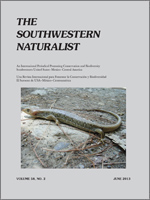We compared types and volume of prey in the diets of two whiptail lizards (Teiidae), Aspidoscelis marmorata (a bisexual species) and A. tesselata (a unisexual species) that occur syntopically in a Chihuahuan Desert landscape on Indio Mountains Research Station, Hudspeth County, Texas. Because their home ranges overlap extensively, we hypothesized that there would be dietary resource partitioning between the two species. Stomach contents of 69 A. marmorata and 21 A. tesselata included only arthropods. Aspidoscelis marmorata used 14 orders of arthropods for prey, while A. tesselata used eight orders. Isopterans (termites) were the principal food for both species by count (93.5 and 83.8% in male and female A. marmorata, respectively; 94.6% in A. tesselata). By volume, Homoptera (37.8 and 10.3%), Araneae (11.9 and 54.1%), Orthoptera (18.0 and 0.9%), and Isoptera (16.6 and 3.6%) composed 84.3 and 68.9% of the diet of male and female A. marmorata, respectively; whereas Orthoptera (29.8%), Homoptera (29.7%), Araneae (16.6%), and Isoptera (16.2%) were 92.3% of the diet of A. tesselata. The hypothesis that syntopic A. tesselata and A. marmorata were partitioning food resources on the study area was not supported; both species are opportunistic feeders that consume similar food types.
Comparamos el tipo y volumen de presas en la dieta de dos lagartijas de la familia Teiidae, Aspidoscelis marmorata (bisexual) y A. tesselata (unisexual), que ocurren sintópicamente en la Estación de Investigación, Indio Mountains Research Station, en el condado de Hudspeth, Texas, localizada en el desierto chihuahuense. Se asumió una repartición de recursos en la dieta de las dos especias debido a que sus rangos de hogar se sobreponen ampliamente. Los contenidos estomacales de 69 A. marmorata y 21 de A. tesselata incluyeron solamente artrópodos. Las presas consumidas por A. marmorata pertenecieron a 14 órdenes, mientras que las presas de A. tesselata pertenecieron a 8 órdenes. Por conteo, ambas especies consumieron isópteros (termitas) principalmente (93.5% y 83.7% en machos y hembras de A. marmorata, respectivamente; 94.6% en A. tesselata). Por volumen, Homoptera (37.8% y 10.3%), Araneae (11.9% y 54.1%), Orthoptera (18.0% y 0.9%), e Isoptera (16.6% y 3.6%) formaron el 84.3% y 68.9% de la dieta de machos y hembras de A. marmorata, respectivamente; mientras que Orthoptera (29.8%), Homoptera (29.7%), Araneae (16.6%), e Isoptera (16.2%) formaron el 92.3% de la dieta de A. tesselata. Los resultados contradicen la hipótesis indicando que las dos especies sintópicas no se reparten los recursos alimentarios; ambas especies son oportunistas que consumen presas similares.





